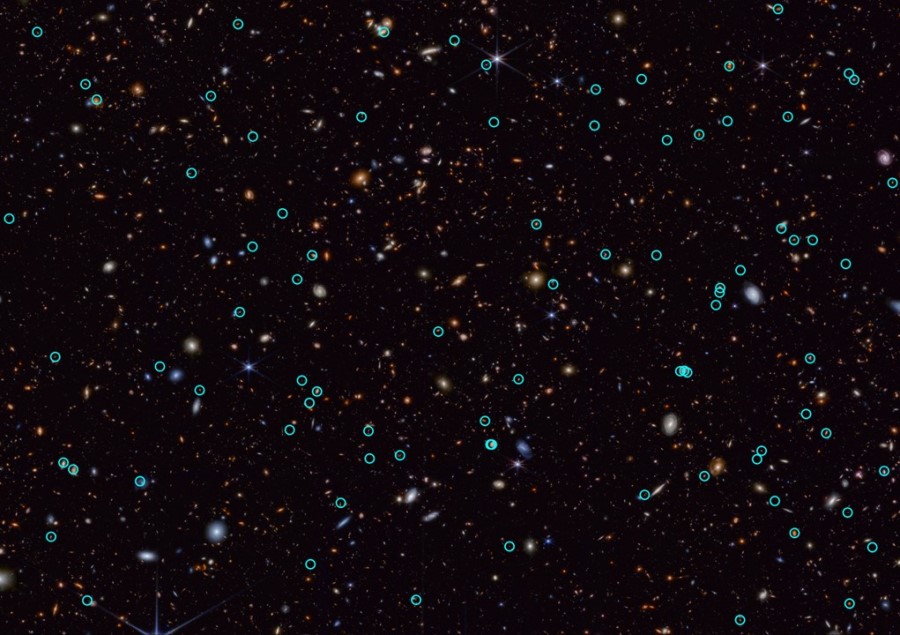Peering deeply into the cosmos, NASA’s James Webb Space Telescope is giving scientists their first detailed glimpse of supernovae from a time when ou
Peering deeply into the cosmos, NASA’s James Webb Space Telescope is giving scientists their first detailed glimpse of supernovae from a time when our universe was just a small fraction of its current age, reported NASA.
A team using Webb data has identified 10 times more supernovae in the early universe than were previously known. A few of the newfound exploding stars are the most distant examples of their type, including those used to measure the universe’s expansion rate.

“Webb is a supernova discovery machine,” said Christa DeCoursey, a third-year graduate student at the Steward Observatory and the University of Arizona in Tucson. “The sheer number of detections plus the great distances to these supernovae are the two most exciting outcomes from our survey.”
DeCoursey presented these findings in a press conference at the 244th meeting of the American Astronomical Society in Madison, Wisconsin.
To make these discoveries, the team analyzed imaging data obtained as part of the JWST Advanced Deep Extragalactic Survey -JADES- program. Webb is ideal for finding extremely distant supernovae because their light is stretched into longer wavelengths — a phenomenon known as cosmological redshift.

Prior to Webb’s launch, only a handful of supernovae had been found above a redshift of 2, which corresponds to when the universe was only 3.3 billion years old, just 25% of its current age. The JADES sample contains many supernovae that exploded even further in the past, when the universe was less than 2 billion years old.
Previously, researchers used NASA’s Hubble Space Telescope to view supernovae from when the universe was in the “young adult” stage. With JADES, scientists are seeing supernovae when the universe was in its “teens” or “pre-teens.” In the future, they hope to look back to the “toddler” or “infant” phase of the universe.

To discover the supernovae, the team compared multiple images taken up to one year apart and looked for sources that disappeared or appeared in those images. These objects that vary in observed brightness over time are called transients, and supernovae are a type of transient. In all, the JADES Transient Survey Sample team uncovered about 80 supernovae in a patch of sky only about the thickness of a grain of rice held at arm’s length.
“This is really our first sample of what the high-redshift universe looks like for transient science,” said teammate Justin Pierel, a NASA Einstein Fellow at the Space Telescope Science Institute (STScI) in Baltimore, Maryland. “We are trying to identify whether distant supernovae are fundamentally different from or very much like what we see in the nearby universe.”

Pierel and other STScI researchers provided expert analysis to determine which transients were actually supernovae and which were not, because often they looked very similar.
The team identified a number of high-redshift supernovae, including the farthest one ever spectroscopically confirmed, at a redshift of 3.6. Its progenitor star exploded when the universe was only 1.8 billion years old. It is a so-called core-collapse supernova, an explosion of a massive star.

The early universe was a very different place with extreme environments. Scientists expect to see ancient supernovae that come from stars that contain far fewer heavy chemical elements than stars like our Sun. Comparing these supernovae with those in the local universe will help astrophysicists understand star formation and supernova explosion mechanisms at these early times.
“We’re essentially opening a new window on the transient universe,” said STScI Fellow Matthew Siebert, who is leading the spectroscopic analysis of the JADES supernovae. “Historically, whenever we’ve done that, we’ve found extremely exciting things, things that we didn’t expect.”
“Because Webb is so sensitive, it’s finding supernovae and other transients almost everywhere it’s pointed,” said JADES team member Eiichi Egami, a research professor at the University of Arizona in Tucson. “This is the first significant step toward more extensive surveys of supernovae with Webb.”
All Credit To: NASA, ESA, CSA



COMMENTS